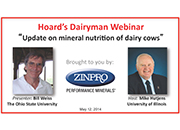 While the 2001 National Research Council (NRC) has been an ally of nutritionists for years, Bill Weiss' research and experience have proven that some of the minimum levels set in the NRC guidelines are low and should be increased to meet the needs of today's dairy herds.
While the 2001 National Research Council (NRC) has been an ally of nutritionists for years, Bill Weiss' research and experience have proven that some of the minimum levels set in the NRC guidelines are low and should be increased to meet the needs of today's dairy herds.Weiss' webinar presentation, "Update on mineral nutrition of dairy cows," on Monday, May 12, covered seven important minerals needed in lactating dairy cow rations. The Ohio State University professor focused on phosphorus, potassium, magnesium, sulfur, copper, chromium and manganese.
An age-old question is whether it is better to underfeed a mineral or overfeed it. It is hard to measure, but a location in the middle should be where we focus our attention, said Weiss.
The lactating dairy cow needs feedstuffs for maintenance, gestation, growth and lactation. With minerals' small physical contribution to the ration, they can still make a big difference, he said. There's little margin for error, especially with trace minerals.
"It is all about risk management," remarked Weiss. Underfeeding or overfeeding comes with a risk. Underfeeding could limit a cow's producing potential. The relationship some minerals have with each other should also be taken into consideration when analyzing one mineral's contribution to the ration.
While initially not very noticeable, overfed minerals will accumulate in the cow's body. Overfeeding also has a high purchase cost, and if there's no gain, it provides no benefit to the animal or profitability. Further down the path, excess could be excreted in manure and feces, which may have an environmental impact.
Underfeeding could mean lost production, and the other extreme could be death loss due to toxicity. Find the tolerable midrange levels, Weiss advised, and he gave insight on where those are.
Weiss would lean toward moderate overfeeding of many minerals (when compared to NRC guidelines), up to 20 to 50 percent over recommendations. He provided guidelines and discussion for those seven minerals in the hopes that producers and their nutritionists would evaluate their current feeding practices and look for minerals that may be shortchanged in the diets.
Weiss warned that each farm is different and should be treated as an independent case. Even two farms with the same feedstuffs, separated by just a few miles, will have variances in mineral needs.
The May presentation was brought by Zinpro Performance Minerals. (www.zinpro.com/dairy) This May webinar is archived and available for viewing. Past webinars can be found at www.hoards.com/webinars.

The author is the online media manager and is responsible for the website, webinars and social media. A graduate of Modesto Junior College and Fresno State, she was raised on a California dairy and frequently blogs on youth programs and consumer issues.








